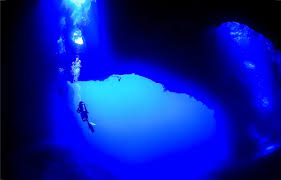Looking Down with Confidence: Turning the Abyss into Your Playground
In our journey of Overcoming Scuba Diving Fears, there is one fear that is perhaps the most primal and visual: the fear of depths (bathophobia). It’s that overwhelming feeling of looking down into an endless blue expanse and seeing no bottom. Our brain, accustomed to solid ground, can interpret that space as danger, as a freefall.
At Amadive, we don’t see this as an irrational fear. We see it as a natural response that needs to be understood and managed with skill and control. This article will detail how the PADI training program transforms the feeling of an uncontrolled “fall” into a purposeful “stroll,” helping you master the depths instead of fearing them.

Decoding the Fear: Why Does the Abyss Cause Anxiety?
- Loss of a Reference Point: On land, we always have the ground as a reference. Underwater, especially on wall dives, losing sight of the bottom can cause disorientation and a sense of vertigo.
- The Physical Sensation of Pressure: As you descend, pressure increases and acts on your body, especially your ears and sinuses. If not managed correctly, this physical discomfort can be interpreted by the brain as a danger signal, amplifying the anxiety about depth.
- The Psychological Factor: The abyss is associated with the unknown. “What’s down there?” – this question can stimulate the imagination in a negative way if not filled with knowledge.
The PADI System: Building Confidence Meter by Meter
The PADI Open Water course is designed to systematically address each of these factors.
1. You Don’t “Fall,” You “Fly” with Control
This is the most critical mindset shift.
- The Skill of Buoyancy Control: You will learn to use your Buoyancy Control Device (BCD) like a pair of wings. By adding or venting small, precise amounts of air, you can control your rate of descent to the centimeter.
- Amadive’s Experience: In the pool, we will have you practice the “hovering” skill until it’s mastered. When you can hold yourself motionless at a specific depth without using your hands or feet, you realize you have total control over your position in three-dimensional space. This feeling is incredibly empowering.
2. Mastering Pressure: Turning Discomfort into a Useful Signal
- The Skill of Equalization: This is the first practical skill you learn. We will teach you various techniques (Valsalva, Frenzel) and emphasize the golden rule: “Equalize early, often, and gently.”
- Shifting Perception: Once mastered, the feeling of pressure on your ears is no longer a threat. It becomes a useful signal, a gentle reminder from your body that “it’s time to equalize.” You are having a conversation with the depth, not being defeated by it.
3. The Principle of Safe Progression
- Depth Limits by Certification: The Open Water course limits you to a maximum of 18 meters. Your first ocean dives will be in very shallow areas (5-10 meters) with a clearly visible bottom.
- The Presence of a Professional: Your PADI Instructor is always by your side, observing and ready to assist. They will never take you to a depth you are not ready for. This trust in your guide is a powerful antidote to anxiety.
Practical Tips to Feel More Comfortable

- Use a Reference Line: For your first few descents, going down along an anchor line or a gently sloping reef provides a tangible visual reference, which dramatically reduces the feeling of disorientation.
- Look Across, Not Just Down: Instead of focusing on the abyss below, turn your gaze to the reef or wall beside you. Observe the life, the colors. This shifts your focus from fear to discovery.
- Breathe Out: When you feel a wave of anxiety, focus on a long, slow exhale. A controlled exhalation triggers your nervous system’s relaxation response.
Frequently Asked Questions (FAQ)
- How will I know what depth I’m at?
- Every diver is equipped with a depth gauge or a dive computer. You will always know your exact position in the water column.
- Is it more dangerous to dive deeper?
- Diving deeper has managed risks (like nitrogen narcosis and shorter no-decompression limits), but that is what you learn to handle in the Advanced Open Water course. Within your limits, and by following the rules, diving at 18 meters is just as safe as diving at 10 meters.
Conclusion: Conquering a New Space
The fear of depths is fundamentally a fear of losing control. The entire modern scuba training process is a series of exercises designed to give you that control. When you trust your skills, your equipment, and your guide, the deep blue abyss ceases to be a threat and becomes an invitation to a new world of wonders waiting to be explored.
Important Disclaimer: Building confidence with depth must be done gradually and under professional supervision. Never try to push your limits alone.
